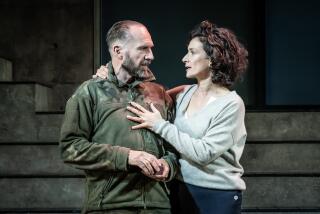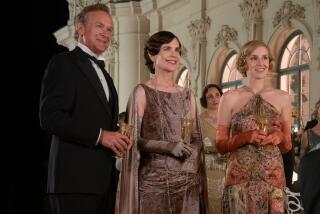‘Downton Abbey’ breaks our hearts and shows our world being born

- Share via
Another season of “Downton Abbey” has swiftly gone by, and those of us who are fans deserve a break.
The tragic death of one character -- Lady Sybil -- was hard enough to take, but when the final episode concluded with the upright Matthew Crawley dying in a car wreck reminiscent of the opening scene in “Lawrence of Arabia,” it was simply too much manipulation of our tender heartstrings. We need some time to grieve while the writers concoct new twists in a storyline that had tied up most of the loose ends at the close of Season 3.
I confess I’ll not miss Matthew all that much. After he got through the curious torture of deciding whether to accept a fortune from the will of his dead fiancee’s father (was there ever any doubt that he’d take the money and save Downton?), he became a rather bland presence in the crowded cast.
I loved his vintage sports cars but was put off by his weak English chin (too much like my own, I suppose). His prickly, complicated wife, Mary, is the character viewers of the show hate or love (I think she’s terrific), and she was getting a bit too domesticated by being married to him. Now, she’ll be free to let her sharp edges poke through in a new plotline for the next season.
The actor who played Matthew, Dan Stevens, wanted out of the series, as did Jessica Brown-Findlay, the actress who played the spunky and sweet Sybil. This necessitated the dual deaths; not necessarily a choice a writer would make unless forced into it.
Still, just as Mary is now free to become a more interesting character again, Tom -- Sybil’s chauffeur-turned-husband -- became a more multi-dimensional character once he left behind his darling wife and his tiresome preaching about Irish liberty. (Egad, could there be a chance for mourning-driven romance between Tom and Mary?)
The glory of “Downton Abbey” is its devotion to historical detail. Though this sometimes leads to characters and plot points too obviously engineered to teach the audience about how life back then was oh-so-different from our egalitarian era, it is still great fun. I have long thought that if I were able to travel back in time, I would not journey all that far. The early decades of the 20th century would be fascinating enough for me.
Apparently, I am not alone in thinking the 1910s, ‘20s and ‘30s have an unusual appeal. I am just one person in the big audience that is peering through the window of time opened by “Downton Abbey.”
Any one of us could step into that society and not feel totally alien, yet it would be wildly different in so many particulars. The world we live in now was being born back then -- women asserting themselves, America rising to power, old empires slipping away, the walls between classes breaking down, medical care on the threshold of a scientific revolution.
We are happy to live in a time when homosexuality is no longer a crime and any person of any economic condition or race or gender has a far better chance to rise to the top. Still, we know we have lost a bit of elegance and quaint charm along the way. “Downton Abbey” lets us appreciate where we are now, but also allows us to indulge in nostalgia for what has been left behind.
Though death has been a wrenching preoccupation of the now-concluded season of “Downton Abbey,” the ongoing fascination for the show’s fans is the chance to see our modern age springing to life.
More to Read
Get the L.A. Times Politics newsletter
Deeply reported insights into legislation, politics and policy from Sacramento, Washington and beyond. In your inbox three times per week.
You may occasionally receive promotional content from the Los Angeles Times.











